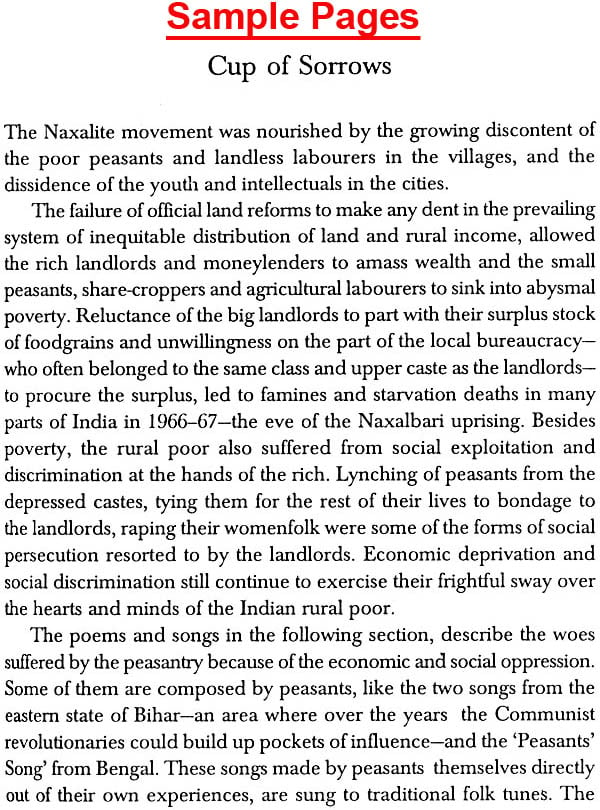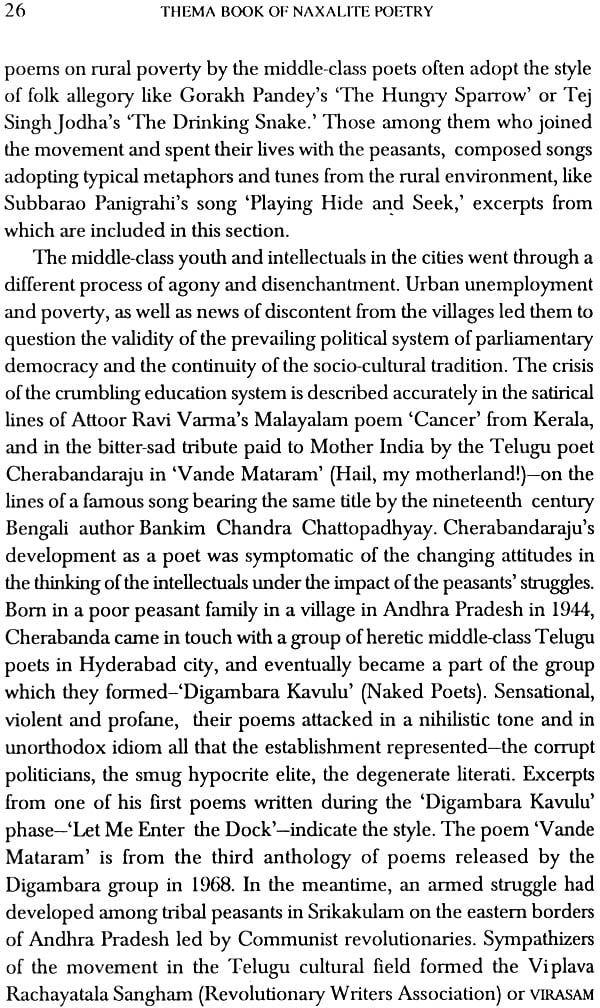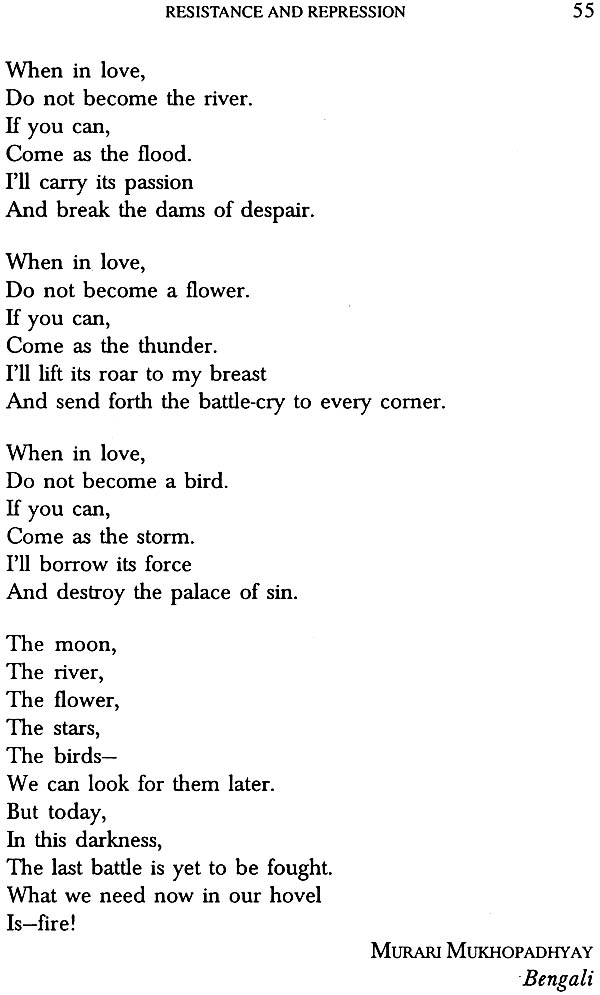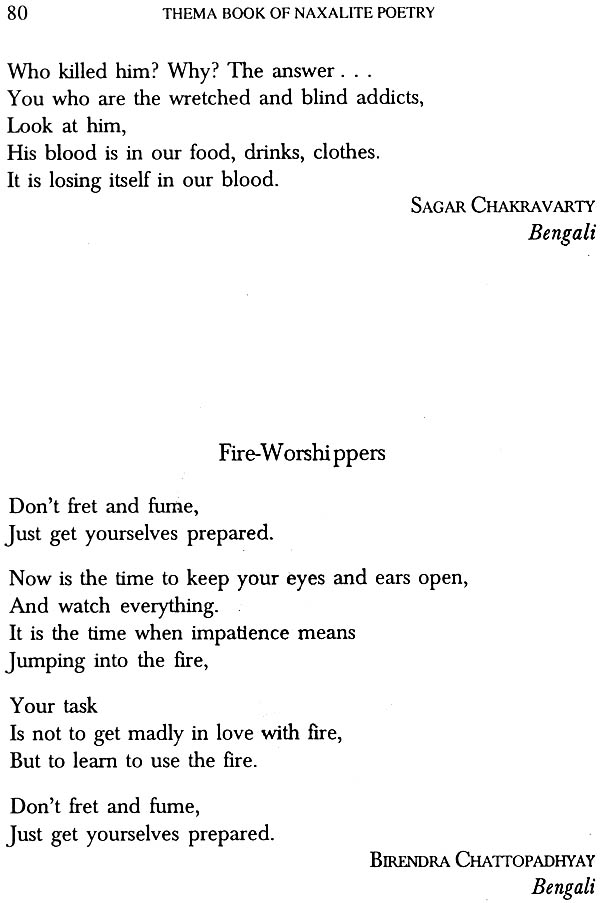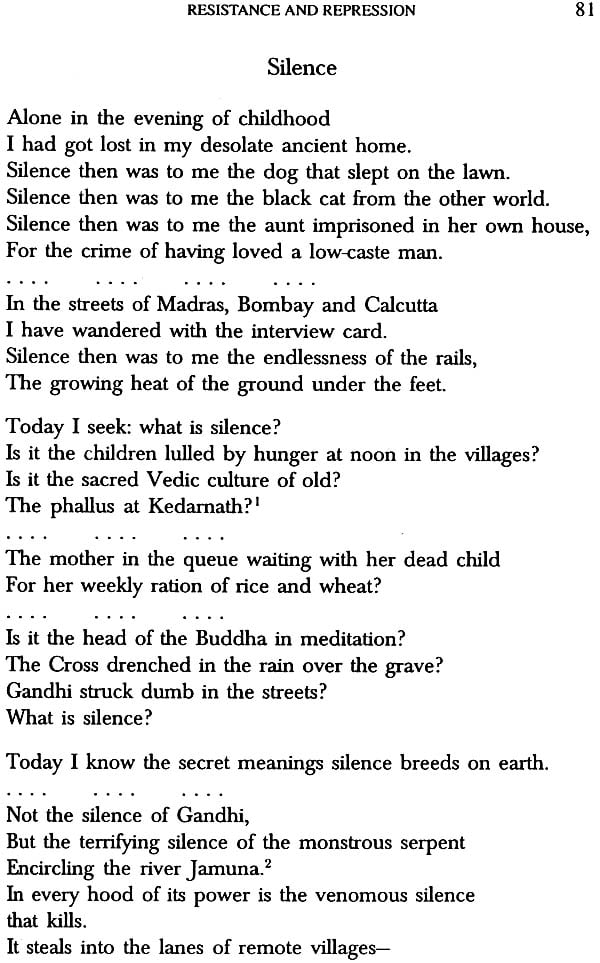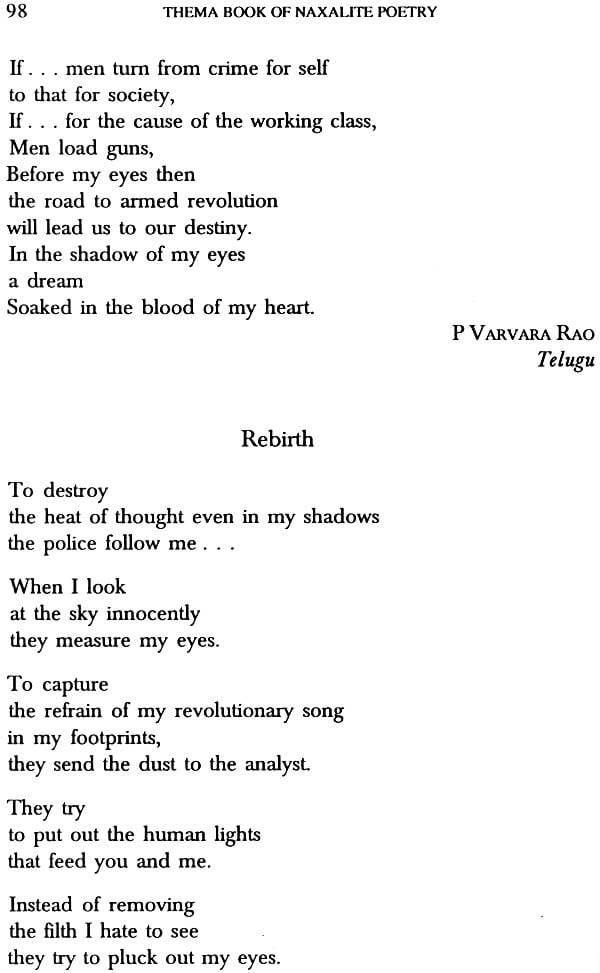
Thema Book of Naxalite Poetry
Book Specification
| Item Code: | NAN228 |
| Author: | Sumanta Banerjee |
| Publisher: | Thema Books, Kolkata |
| Language: | English |
| Edition: | 2022 |
| ISBN: | 9789381703175 |
| Pages: | 138 |
| Cover: | Paperback |
| Other Details | 8.5 inch X 5.5 inch |
| Weight | 170 gm |
Book Description
Sumanta Banerjee, author of The Simmering Revolution, the most objective and authoritative account till date of the Naxalite Revolt of the late sixties and early seventies, places his collection of Naxalite poems and songs, both urban and rural, in a fairly elaborate theoretical matrix that gives a short account of the Revolt through its various phases, and how it redefined the social function of literature, and goes into an analysis of the changing attitudes of the participants and sympathetic observers. An introductory chapter studies the exploitative system that led to the Revolt, and a concluding chapter records the revaluations that came to be made once the more militant phase of the movement was over. The literary material drawn from the most varied sources, both printed and oral, represents a wide range of authorship including urban, rural and tribal activists, some of the martyrs themselves, traditional folk singers, and established poets.
It is now more than twenty years since Thema Book of Naxalite Poetry first appeared. In those two decades, several changes have taken place in India-and also in the course of the Naxalite movement which was the backdrop of the poems and songs that the book brought together at that time. Yet, behind the changes, there is a continuity. Despite all the promotional ballyhoo about India's upward mobility in the economy and politics of 'globalization', vast sections of our people continue to be victims of the oppressive socioeconomic order against which some forty years ago the CPI (Marxist- Leninist) launched an armed insurrection which came to be known as the Naxalite movement. During the last two decades, the movement (led now by the CPI-Maoist party) spread beyond its earlier areas of operation. By organizing resistance against the exploitation and persecution of feudal landlords and predatory industrialists, its leaders have been able to bring under its fold poor peasants and agricultural labourers, primarily from socially ostracized castes and tribal forest dwellers inhabiting a vast corridor stretching from Bihar in the north, to Jharkhand and Orissa in the east, through Madhya Pradesh, Maharashtra and Chhattisgarh in the centre, down to Andhra Pradesh and Tamil Nadu in the south. The spread of the Naxalite movement is, in an ironical sense, a violent tribute to the Indian state's perpetuation of the inequitable socioeconomic power structure.
When the present anthology was first published in 1987, it sought to introduce to readers the cultural texture of a particular phase of the Naxalite movement, which till then had been less known. It was a selection from the literature that was thrown up by the initial tide in the movement during the late 1960s-early 1970s period followed by its setback (to be found in the poems in the first three sections). It ended with a description of the ebb in the movement in the late 1970s-early 1980s, reflecting the mood of introspection about the past and contemplation about the future among its followers (in the concluding section entitled 'Retrospection'). In the present edition, the original introduction as well as the rest of contents-are being left untouched, to enable the readers to get a glimpse of the historical perspective which brought forth the literature. Besides, their relevance is not lost today, since most of the poems and songs included in that edition sound like echoes of what is happening today in the villages of Jharkhand, Chhattisgarh, Andhra Pradesh and other parts of India. The hopes and fears expressed in the last introductory section of 'Retrospection' continue to be aroused by the actions of the present generation of Maoist activists-sometimes by their positive efforts to eradicate inequality in their zones of influence, sometimes by their cruel misdeeds that violate humanitarian values and bewilder and alienate their sympathizers.
The anthology compiled at that time however could not claim to be a comprehensive representation of Naxalite literature. Although there were attempts to include the voices of the tribal and dalit poets and singers, it was predominated by middle class writers. One major absentee was-the woman. Today, a new generation of cultural activists in the Maoist movement are coming up from among these disadvantaged sections who can be described as 'organic intellectuals' in the Gramscian sense. They weave their emotional yearnings with their political aspirations in songs that blend literary metaphors with agitprop. Deep in the forests of the Maoist- dominated Dandakaranya in central India today, a song composed by Gondi tribal women for instance, begins by expressing the poignancy of a young girl forced into marriage by her parents:
In the darkness of no moon, In the light of full moon,
In the deep forest I am alone.
I put my foot forward, I take a step backward.
Wherever I step it is dark, brother...
and ends with the political message of her joining the Maoist movement to 'go forward towards a red dawn.'
The same message is framed in more metaphorical terms in another song which ends with the words:
The land and sky are equal, women and men are equal. (Quoted from The Revolutionary Women's Movement in India, New Vistas Publications, Delhi 2004)
These songs of the present Naxalite-Maoist generation await new compilers. Meanwhile, we republish this old anthology which had been out of print a few years, to meet a long-standing demand from readers. Historically also, it serves a useful purpose by providing a cultural record of the experiences of the earlier generation, who heralded a radical movement that continues to be a force to reckon with in Indian politics.
Wars and their heroes have stepped down from the pages of our ancient epics as living letters in the streets and fields, hills and jungles of India today. The poems brought together in this anthology are about these living letters. They describe an important turning point in a war that is still on, and the mood of the men and women who are fighting it.
In the long war waged by the Indian people against oppression, the late 1960s initiated a major phase. In May 1967, there was a peasant uprising in Naxalbari-in the north-eastern tip of India. It was led by armed Communist revolutionaries, who envisaged the setting up of liberated zones and parallel centres of power that would put an end to the age-old oppression of feudal landlords and bring about the long-awaited land reforms. Although the uprising was crushed by the police within a few months, from then on nothing could ever be quite the same in India. The chain reaction that followed shook up not only India's political milieu, but also the social and cultural scenario in many parts of the country. A succession of militant struggles by the rural poor in different areas of India illuminated for the first time a cobwebbed, discreetly shadowed corner of the country's socioeconomic life-the world of the landless and poor peasants who had had a raw deal for ages. Their actual condition had remained obfuscated behind the official propaganda of 'socialism' and 'land reforms.' The Naxalite movement led by the Communist Party of India (Marxist-Leninist) and other groups of armed Communists, which developed around the core of these struggles, reached its peak in the early 1970s, to be followed by a setback caused by ruthless persecution by the State and dissensions within the movement. But in the course, the middle classes were shaken out of their torpor, with the sensitive among them beginning a journey of introspection and rethinking- sceptically re-examining their cultural roots, questioning the validity of the prevailing political system and tearing apart the veneer of parliamentary democracy which had hidden from them for the last two decades since independence in 1947 its record of economic failures and oppression of the rural poor. Some among the middle classes even dared to cross the carefully laid out boundaries of their socio-economic environment and join the embattled peasantry in their struggle against the feudal oppressors and the State, as well as stage rebellions in the cities. Thus, urban protest activities came to be an important component of the Naxalite movement.
The struggle still continues in the villages of Andhra Pradesh, Bihar and other parts of India, proving once for all that the massive repression of 1972 has neither muffled the voices of popular grievances that had stimulated the Naxalite movement, nor refuted the validity of armed struggle.
The political events of those turbulent decades of the 1960s and 1970s-the shooting down of young revolutionaries in the streets of Calcutta, the latter's retaliation against the police, the pitched battles in the countryside of Andhra Pradesh, Bihar, Orissa and Punjab, the killings in police custody and the jail-breaks-have so engrossed the attention of posterity, that it is necessary to remind people that hand in hand with those political happenings, there flourished a rich crop of literature-poems and songs composed by the participants themselves as well as sympathetic observers, some published in obscure small magazines, many remembered by word of mouth and still sung in villages. To understand India today, it is essential to listen to these poets-both the middle class writers of the cities and the more earthy poets of the villages.
Poetry of all ages may be read on several levels; for its sound and rhythm; for its content and imagery, for inspiration, or for entertainment. The present collection seeks to give the readers an idea of these various layers contained within the poetry of the Naxalite movement, which speak at different levels of understanding. The poems in this anthology withhold themselves from none. But quite understandably, they yield themselves with ease to those who are prepared to listen to them.
Readers of this anthology-as well as serious readers of poetry everywhere-should agree that poems demand a sympathetic audience upon whom they can rely for their understanding of the context in which these poems were born. A generally shared experience like love, or the beauty of a landscape, may make it easier for a poem to communicate to all-although even here, the fact that norms, experiences and images differ from society to society, stands in the way of universal appreciation of such poems.
CONTENTS
| Preface to the second edition | vii | |
| Introduction | 1 | |
| 1 | Cup of Sorrows | 24 |
| 2 | Resistance and Repression | 48 |
| 3 | Poems from Jail | 88 |
| 4 | Retrospection | 106 |
| Notations | 123 |
